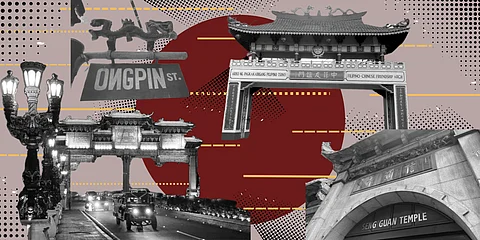
- NEWS
- the EDIT
- COMMENTARY
- BUSINESS
- LIFE
- SHOW
- ACTION
- GLOBAL GOALS
- SNAPS
- DYARYO TIRADA
- MORE

Binondo, Manila’s bustling Chinatown, is more than just a food lover’s paradise — it’s a vibrant district steeped in history, culture, and tradition. Known as the oldest Chinatown in the world, Binondo is a testament to centuries of trade and interaction between Chinese immigrants and Filipinos.
From historic landmarks to culinary gems, Binondo offers a unique blend of the old and the new. Here’s your guide to exploring this dynamic district:
Start your Binondo adventure with a stroll across the iconic Jones Bridge. Originally designed in 1920 by architect Juan Arellano, this neo-classical bridge has been restored to its near-original splendor, with gold-painted steel girders, ornate lampposts, and beautifully lit LED fixtures. The bridge offers a stunning gateway to Chinatown, especially at night.
At the end of Jones Bridge, you’ll find the towering Binondo Chinatown Arch. Standing 63.8 feet tall and 74 feet wide, this modern pagoda-inspired landmark welcomes visitors with grandeur and serves as the perfect photo spot to begin your exploration.
Located just a few meters away from the Binondo Chinatown Arch, the Filipino-Chinese Friendship Arch is one of four similar structures in Binondo. Built in the 1970s, these arches commemorate the formalization of diplomatic relations between the Philippines and China on June 9, 1975. Interestingly, these structures were funded by the Tsinoy, or Filipino-Chinese, community and serve as a lasting symbol of friendship and unity.
The Basilica de San Lorenzo Ruiz, better known as Binondo Church, is a historic gem. Founded in 1596 by Dominican priests, it has stood the test of time, surviving wars and natural disasters. It honors Lorenzo Ruiz, the first Filipino saint, who was born in Binondo and martyred in Japan.
A food lover’s paradise, Ongpin Street is packed with eateries offering Chinese-Filipino favorites like dim sum, noodles, and hopia. Named after patriot Don Roman Ongpin, the street also features shops selling jewelry, charms, and traditional medicines.
Dubbed the “Queen of the Streets,” Escolta was once Manila’s prime business district. Today, it has transformed into an artistic hub. You’ll find historic buildings like the El Hogar, Regina Building, and First United Building, which now house art galleries, co-working spaces, and events that celebrate Filipino creativity.
Located on Juan Luna Street, Grand Café 1919 offers a charming blend of history and modernity. Housed in the former main office of the Hong Kong & Shanghai Banking Corporation (HSBC), this 1921 neoclassical building has been beautifully restored. Its interiors retain the 23-foot high ceilings, intricate grill windows, marble floors, and columns, with a modern mezzanine floor for extra seating.
The café’s walls showcase vintage photos of Binondo’s glory days, and a plaque shares the building’s rich history. Pair the ambiance with their excellent coffee and pastries, and you’ve got a perfect spot for a break.
Located at 413 Escolta Street, HUB Make Lab breathes new life into Escolta as a cultural hotspot. Once a bustling commercial district in its heyday, the First United Building now hosts creative spaces, pop-up shops, and artistic events, making it a must-visit for art and history lovers.
A spiritual retreat in the heart of Binondo, Seng Guan Temple is the largest Buddhist temple in the country. Admire its stunning façade, towering stupa, and serene interiors while soaking in the peaceful ambiance.
This unique street-side shrine at the corner of Ongpin and Tomas Pinpin Streets combines Catholic and Buddhist traditions. Locals visit to light incense, pray for blessings, and admire the gold-plated cross adorned with sampaguita garlands.
For those seeking luck or guidance, the Kuang Kong Temple on Kipuja Street is the place to go. Dedicated to Kuang Kong, the Chinese god of war and wisdom, the temple exudes a serene atmosphere with its incense-filled air and intricate altars.
After crossing Jones Bridge or the Binondo-Intramuros Bridge, take a leisurely walk along the Pasig River Esplanade, a scenic promenade that runs along the historic Pasig River. The esplanade offers a peaceful retreat from the hustle and bustle of Binondo, with benches, greenery, and a stunning view of the water.
The newly built Binondo-Intramuros Bridge is a modern marvel connecting two historic districts — Binondo and Intramuros. Spanning the Pasig River, this sleek, white bridge offers stunning views of the waterway and Manila’s skyline. Its elegant design and pedestrian-friendly pathways make it not only a practical crossing but also a scenic route for walkers and bikers exploring these culturally rich areas.
For over 400 years, Binondo has remained a vibrant center of culture, commerce, and community. Through its landmarks, culinary treasures, and modern artistic spaces, this district offers something for everyone.
Whether you’re drawn by its rich history, delicious food, or cultural fusion, Binondo invites you to explore its timeless charm — a place where past and present come alive in the heart of Manila.
